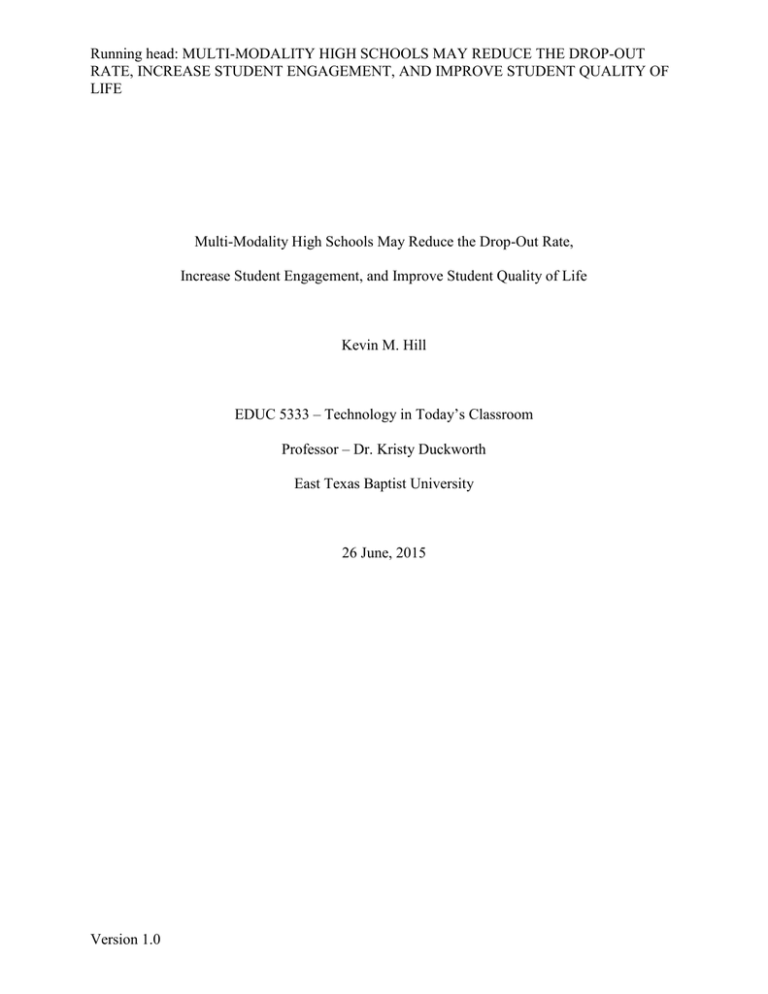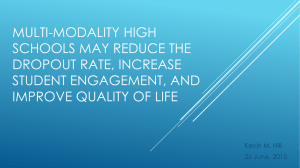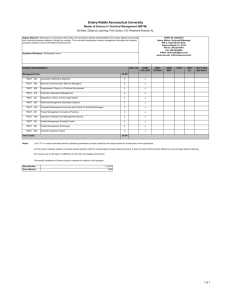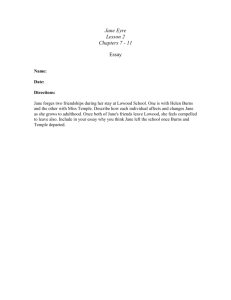File - Chef Kevin Hill
advertisement

Running head: MULTI-MODALITY HIGH SCHOOLS MAY REDUCE THE DROP-OUT RATE, INCREASE STUDENT ENGAGEMENT, AND IMPROVE STUDENT QUALITY OF LIFE Multi-Modality High Schools May Reduce the Drop-Out Rate, Increase Student Engagement, and Improve Student Quality of Life Kevin M. Hill EDUC 5333 – Technology in Today’s Classroom Professor – Dr. Kristy Duckworth East Texas Baptist University 26 June, 2015 Version 1.0 MULTI-MODALITY HIGH SCHOOLS Introduction Technology has had a major effect on the way we function in our everyday life (Hicks, 2011). In the United States, and across the globe, technology in the classroom is on the rise. Hicks (2011), also states that not all educators and administrators have embraced this practice which has left the classroom behind compared to other industries. If we are to remain competitive, in a global society, we must tear down the fears and lack of technological savvy of our educators and administrators. I have been very fortunate in earning my undergraduate degree from the World’s most prestigious aviation university, Embry-Riddle Aeronautical University (ERAU). During my studies, I have attended classes in five different modalities that Embry-Riddle offers; Traditional – synchronous face-o-face in-class delivery; On-Line – 100 percent asynchronous delivery via the Internet; Blended – a combination of traditional and on-line; EagleVision Classroom (EVC); and EagleVision Home (EVH). EagleVision Classroom and EagleVision Home are unique. I was a member of the ERAU team who designed, tested, and implemented this new modality into our delivery options and subsequently completed several master level classes using all five modalities. EVC virtually links remote classrooms, synchronously, to a primary classroom who houses the instructor. This allows for small classes, spread across the globe, to attend classes in a synchronous modality as if they were sitting in front of their instructor in the primary classroom (Embry-Riddle, 2007). Embry-Riddle (2007), further expands its synchronous distant learning modality options via EVH. EVH links several students, many from their homes, with an instructor who may be delivering lectures form their home or office. Home may be a misleading label as it implies one must be at home. That is not the case. For this modality, home can be defined as; your MULTI-MODALITY HIGH SCHOOLS residence, your office, your hotel during travel for work, or even a forward deployed military installation in a war zone. As long as you have Internet access, you are home. ERAU integrates its current technology, such as Blackboard, Oracle, and Microsoft Office with Saba Centra’s state of the art software including web conferencing, e-meetings, recording capabilities, and VoiceOverIP to provide an extremely interactive online synchronous modality serving both EVC and EVH (ERAU, 2007). With the ever expanding need for technology in education and the requirement to serve all students, would creating a program that mimics the five modalities, offered by ERAU, create additional opportunities for student success? Creating additional opportunities may recapture drop-outs, increase student retention because of a rising student engagement, and improve the quality of life for teens who do not attend school because of personal issues? This approach to multi-modality delivery allows for flexibility and choice. Drop-Out Rates According to Galehouse (2002), all 50 states and the District of Columbia (DC) have established laws requiring students to remain n school until a specified date; twenty-nine states require that age to be 16; 8 others set the number at 17, while the remaining 13 and DC mandate 18 years old. Despite these laws, Statistic Brain (2014) estimates that approximately 8,300 students drop out of school each day, 3 million per year. Most drop outs had at least passing grades and stated that grades when they vacated their studies and they stated that with some help they could graduate high school (Hansen & Toso (2007). Listed in their research article, Hansen & Toso (2007), provide us with six categories depicting the main reasons students drop out of school; 1) academic difficulty; 2) poor attendance; 3) Being held back; 4) disengagement; 5) transition to a new school, primarily in the MULTI-MODALITY HIGH SCHOOLS middle of a school year; and 6) other life factors. Other researchers such as Balfanz (2007), refer to the same issues but list them as life events; fade-outs; push-outs; and failure to succeed. Academic Difficulty Academic Difficulty, Hansen & Torso (2007), and Failure to Succeed, Balfanz (2007), synonymously see students who struggle with learning and receive failing grades often get discouraged and simply give up resulting in drop out. Poor Attendance Hansen and Torso (2007), state that a student who is absent one day a week, on average, from their classrooms have a 75 percent dropout rate. The reasons vary with student. Being Held Back Students who have academic difficulty but remain in school often find themselves being held back a grade. This retention within a grade often yields a multi age classroom and the struggling student faces being the oldest in class and all the stigmas that accompany the retention according to Hansen and Toro (2007). Disengagement Teachers did not connect learning to real-life situations, or teachers and parents seemed uninterested in the student’s education was a common theme surrounding drop outs who became bored or uninterested in the learning process (Hanson & Toro, 2007). Transition to New School Today’s families are much more nomadic than decades ago. Parents change jobs, the divorce rate is higher, and military children move on an average of every three years. Students in these categories often find the new school will be much harder, causing frustration, or much MULTI-MODALITY HIGH SCHOOLS easier, causing boredom, and drop out according to according to Hansen & Toro (2007). These changes can be placed in any one of, or all of, Balfanz’s (2007), reasons for dropping out. Other Life Factors Hansen & Toso (2007) and Balfan (2007), may have different category names for the reasons student drop out, but their categories, Other Life Factors and Life Events, respectively, are nearly identical. In these categories fall, pregnancy, family problems, arrest, financial problems leading to the requirement to choose work over school, are key factors in high dropout rates we see today. Technology in Teaching/Learning In the Home Statistics According to Woolfolk (2013), digital media and technology, to include smartphones, i products, tablets, laptops, along with clouds, Facebook, Twitter, Instagram, Snap Chat…and many more have changed the way we live and the world in which we live. In 2012, 71 percent of American Households, with children from 0 to 8, own a smart phone and 42 percent also own tablets (Woolfolk, 2013). With these devices, coupled with multiple televisions in the home, kids spend only more time sleeping than being digitally engaged. She also proceeded to say that homework often includes the use of these devices for research and communications with classmates via e-mail, text, or the sharing of files in collaborative learning. In the Class Statistics In 2009, approximately 97 percent of teachers had one or more computers in their classrooms and 57 percent were allowed to bring in their own for instructional purposes. Nearly 93 percent of those with computers and 96 percent of those who utilized their own device had Internet access within their classrooms. In the United States, the student to computer ratio was MULTI-MODALITY HIGH SCHOOLS 5.3 to 1. These statistics were obtained from the Institute of Educational Services (2015), an entity within the U.S. Department of Education. The article does not address mobile devices such as smartphones, tablets, or laptop computers which would increase the devices present in the classroom substantially. A vital statistic, also shown within the Institute of Educational Services article (2015), was that 57 percent of teachers either have in their classrooms, or have access to, interactive white boards, a tool that increases the effectiveness of the traditional, blended, EVC and EVH modalities mentioned previously. This device can be used, asynchronously, within the online modality but does not provide any extra efficiency. Student Engagement Blessinger & Wankel (2013) define student engagement as a conscious awareness and desire of a student to invest time and resources to successful grasp and utilize, in a meaningful way, the information they are attempting to learn. Meaningful can be seen as useful for the application within their everyday life either currently or in the future. A key factor in establishing student engagement is motivating them to learn. Lacina, Mathews & Nutt (2011), convey that teachers use technology in their classrooms as a motivator and frequently use it as a reward for efforts put forth in non-technological delivery and learning. They also state that technology in the classroom is an effective means of creating student interest in content area and is a purposeful manner in which to build upon prior knowledge. Conclusion I would like to conclude this assignment in an unconventional way. I am presenting to you a scenario that will put the content of this paper into perspective and display a case where a MULTI-MODALITY HIGH SCHOOLS Multi-Modality High School will make an at risk student be successful while battling an all-toreal situation that many teens are facing today. Scenario Jane Doe is a successful student at XYZ High School and is enthusiastic about her studies as shown by her class ranking of 5 out of 275. Jane makes an all too common mistake that many teens do today, she finds herself pregnant. Being from a Christian Family she does not contemplate abortion. Jane attends school as normal but is finding that her peers are shying away from the usual conversations and not inviting her to after school gatherings that she enjoyed until now. She becomes disinterested in school and her grades are dropping. She wants to give up and drop out. Jane’s parents are very supportive and speak with school staff regarding a way to remotivate and reengage Jane, as she has a bright future with a great support system. The school principle mentions a pilot Multi-Modality High School concept that is being sponsored by the Bill & Melinda Gates Foundation. The program will be paid by public funds and grants from the foundation. Jane and her family decide that they will give the program a try. Jane enrolls in and successfully completes an Online, asynchronous, class in home economic that satisfies an elective and prepares her for routines she will need post-partum. Janes parents decide that it be best if they move as to allow Jane to make new friends after she returns to school after the baby is born. Jane enrolls in another online class and simultaneously enrolls in a short Blended course at her new school that is a member of the Multi-Modality consortium. She is not showing but does have many doctors’ appointments to attend so she attends face-toface (synchronous) one day per week class in algebra and satisfies the reminder of her course via MULTI-MODALITY HIGH SCHOOLS the online modality. This allows Jane time for her appointments but also allows for her to meet personally with the teacher to ask questions and receive clarification of math procedures. The big day has arrived and Jane gives birth to a happy health baby girl. Jane is only three classes form graduating but is finding it difficult to attend these classes because of her responsibilities as a new mother. She reviews the new program’s and sees that a class she needs is offered at the local high school but because of low enrollment numbers it has been scheduled in a synchronous online modality, similar to EVC, that will require 3 students from her school to be in a classroom where it will be linked to a classroom of 15 students that is 400 miles away. She is excited to here that the instructor will travel form site to site and present from each site every other week of the eight week class. Jane still has two classes to register for so she can graduate prior to her 18th birthday, a goal she has set for herself. This would not be possible because an elective she wants to take, to satisfy a college entry requirement, is not offered at her local school. But she sees that the class is being conducted synchronously between seven students, all who live in towns that are quite some distance apart. This allows for the instructor to teach the class from his home, synchronously as seen with EVH, while all seven students attend from their homes. Because of her recent success in the four modalities in which she completed her course, she is becoming re-engaged and excited about completing her course of study. Jane takes a giant leap of faith and decides, with help from her grandmother as a baby sitter, to take her last class in the classroom at her local school, where she can attempt to make new friends and walk the stage at graduation in June. Although this scenario mat be constructed in a perfect world, you can see how once was a probable high school dropout has successfully completed her education and prepared herself for MULTI-MODALITY HIGH SCHOOLS the next level of her education, attending a local university and becoming a counsellor for unwed teen mothers. MULTI-MODALITY HIGH SCHOOLS References Balfanz, R. (2007, May 9). What your community can do to end its drop out crisis: Learning from research and practice. Prepared for the National Summit on America’s Silent Epidemic, Washington, DC. Paper retrieved from http://web.jhu.edu/CSOS/images/finaldropout_Balfanz.pdf Blessinger, P. & Wankel, C. (2013). Increasing student engagement and retention using classroom technologies: Classroom response system and mediated disclosure technologies. [Accession Number 513324]. Retrieved from http://eds.a.ebscohost.com Convisson, K. (n.d.). Why kids drop out of school. EduGuide. Retrieved from http://www.eduguide.org/article/why-kids-drop-out-of-school Embry-Riddle Aeronautical University. (2007, May 31). Embry-riddle worldwide launches eaglevision. Retrieved from http://www.worldwide.erau.edu/newsroom/pressrelease/embry-riddle-worldwide-launches-eaglevision.html Galehouse, M. (2002, January 28). Drop out bill speaks questions. The Arizona Republic, pp. 1-2 Hansen, J. & Toso, S. (2007, Fall). Gifted dropouts. Gifted Child Today, 30(4), 30-41 Hicks, S. (2011, September). Technology in today’s classroom: Are you a tech-savvy teacher? Clearing House, 84(5), 188-191. doi:10/1080/00098655.2011.557406 Institute of Education Services. (2015) Educational technology. Retrieved from http://www.nces.ed.gov/FastFacts/display.asp?id=46 Lacina, J., Mathews, S. & Nutt, L. (2011). Technology integration: Graduate use of technology in their k-8 classroom. Social Studies Research & Practices, 6(1), 149-166 MULTI-MODALITY HIGH SCHOOLS Statistics Brain. (2015, March 17). High school dropout statistics. Retrieved from http://www.statisticsbrain.com/high-school-dropout-statistics/ Woolfolk, A. (2013). The learning sciences and constructivism. In Educational Psychology, (13th ed.). Educational Psychology. (pp. 397-400)






